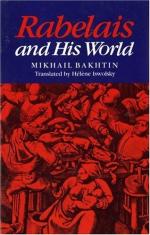
|
| Name: _________________________ | Period: ___________________ |
This test consists of 5 multiple choice questions, 5 short answer questions, and 10 short essay questions.
Multiple Choice Questions
1. Curses in Renaissance folk culture tended to focus most closely upon the victim's:
(a) Mind.
(b) Family.
(c) Body.
(d) Spirit.
2. How does Rabelais accomplish the grotesque degradation of his target in the prologue to the Third Book?
(a) By declaring the targets incapable of the basest bodily functions.
(b) By insulting the targets' mothers.
(c) By declaring the targets to be empty-headed.
(d) By accusing the targets of paganism and crimes against the Church.
3. In the Prologue of the Third Book, to which contemporary events does Rabelais allude?
(a) The Norman Invasion.
(b) The defense of France against Charles V.
(c) The Black Death.
(d) The defeat of the French and Spanish fleets by Admiral Nelson.
4. How does the prologue of _Pantagruel_ demonstrate the connection between literature and the marketplace?
(a) It exhorts its readers to record in writing their own experiences of fairs and of Carnival.
(b) It begins with a detailed description of the author's hometown marketplace.
(c) It offers a pricey alternative to illiteracy.
(d) It simultaneously advertises itself and praises the public.
5. In the Renaissance, bodily excretions were closely associated with:
(a) The social status of the individual.
(b) The inherent evilness or goodness of the individual.
(c) The individual's sexual purity.
(d) The overall health of the individual.
Short Answer Questions
1. What are the "intelligentsia"?
2. The figure of the Physician in the Fourth Book is closely connected with:
3. What does the "form" of any kind of art express?
4. Carnival allowed:
5. Rabelais expresses the debasement of suffering and fear by associating them with:
Short Essay Questions
1. What about the episode of the Lord of Basche is carnivalesque?
2. How does Bakhtin interpret the prologue of _Pantagruel_?
3. How does Rabelais describe the human body in the context of grotesque realism?
4. What is important about the figure of the physician in Rabelais' novel?
5. What is Bakhtin's general idea about the purpose of art?
6. What was the "feast of fools," and why was it a particularly festive laughter in the Middle Ages?
7. How does Bakhtin get around the prohibition of certain kinds of satire and irony in his own time?
8. What do Rabelais' long lists of names and epithets signify?
9. What does Bakhtin mean when he argues that laughter affirms the people's unofficial truth?
10. What role do oaths and profanities fill in Rabelais' novel?
|
This section contains 886 words (approx. 3 pages at 300 words per page) |

|




